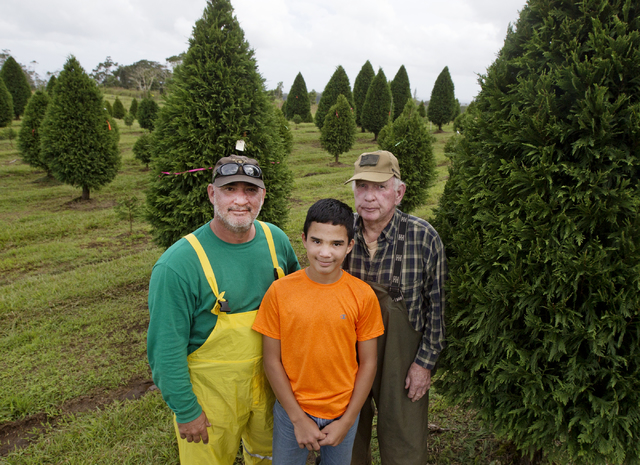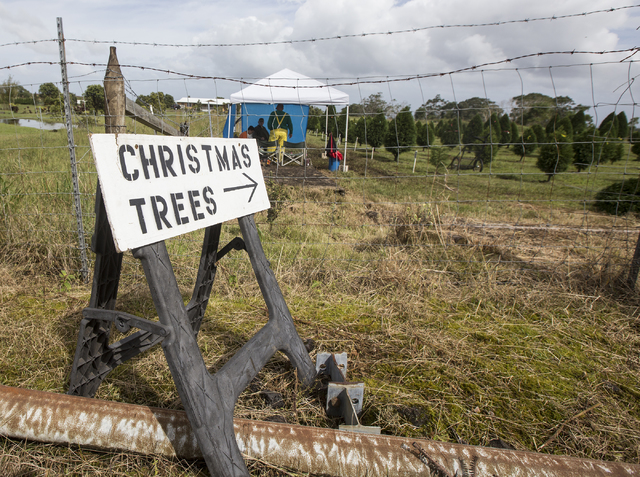If you’re getting a Christmas tree at Hooluana Tree Farm this season, be sure to bring your boots.
It’s the rainy Mountain View and Glenwood microclimate that helps hundreds of Leyland cypress trees on Tom and Luana Beck’s ranch thrive.
The tree farm opens for business each year after Thanksgiving. On Saturday, several of the trees already were marked by a pink strip, for pre-paying customers to pick up closer to Christmas.
“We had a good day yesterday,” Tom Beck said. Some visitors had driven from Waikoloa to choose their tree.
On the mainland, trekking to a Christmas tree farm to select your own tree, cut it down and bring it home, is a common holiday tradition. Beck remembers going out to pick his family’s tree as a youngster, as does his own son, Brad.
In Hawaii, the locally grown Christmas tree market is a small one.
A 2012 state Department of Land and Natural Resources Division of Forestry and Wildlife study found that 96 percent of Christmas trees in Hawaii are conifers shipped from the mainland.
Shipping trees creates potential for invasive insects and slugs to sneak into the state.
One multiagency project, led by the Hawaii Forest Industry Association with help from Hawaii County, the Department of Hawaiian Homelands and the state and federal Departments of Agriculture, hopes to establish a market for Douglas fir trees in the future.
The firs must be grown at high elevation. A plot of seedlings was planted in March on the slopes of Mauna Kea.
“They’re not ready; they’re babies,” said Hawaii Agricultural Research Center horticulturalist Aileen Yeh, who originally conducted demonstration trials for the firs in 2002.
Douglas firs take about seven years to reach market size.
Cypress trees, on the other hand, take just two or three years to get to that point. They are the most common type of Christmas tree in the southeastern United States, according to the National Christmas Tree Association. Douglas firs are more common in the Pacific Northwest.
Yeh and Beck said there was high demand for local trees.
“There is, there really is,” Beck said, adding that if any other farmers are interested in starting their own Christmas tree farm, he and Luana are “more than willing to help with that.”
“For large-scale owners at midelevation, there’s all kinds of trees they can grow,” Yeh said. It’s a matter of matching the tree to the climate.
Last year, the Becks sold about 200 trees.
They began growing Leyland cypress in January 2012 and are now in their third Christmas season (they also raise Wagyu cattle for beef at their ranch and are members of the Hawaii Farm Bureau). In January 2012, they grew a test group of 100 cypress ordered from a Georgia nursery.
“After eight months, they were 54 inches tall,” Beck recalled.
The Becks ordered 300 more trees. They haven’t had to purchase new trees since; the cypress are all grown via cuttings.
Most trees are sold for $10 per foot.
The couple’s foray into the Christmas market was helped by Luana’s horticulture degree and Tom’s knack for cultivating just about any type of plant.
“She’s got the brains; I’ve got the green thumb,” Beck said. He used to raise yellow ohia trees for sales, but cannot sell the trees anymore because of rapid ohia death. Several yellow ohias still grow on the Becks’ ranch; Beck suspects they are protected from the fungus that causes ROD because of the regular fungicide spraying he gives to the cypress trees.
The only serious threats to the cypress trees are hurricanes, which can wipe out new trees by blowing them over, and wild pigs that root up small saplings.
The Becks lost about a third of their trees after Tropical Storm Iselle.
“Every hurricane that comes, we hold our breath,” Beck said.
Cypress grow in a naturally triangular shape, but “they have to be sheared and shaped and shorn,” Beck said. Left unchecked, a cypress can grow to be 80 or 90 feet tall.
A cool green with soft foliage (heavy ornaments will require extra support to be hung from branches), cypress don’t shed needles like pine trees, and don’t produce sap, which makes them hypoallergenic. They have a faint scent once cut, although nowhere near as strong as that of a pine or fir.
“If you keep them watered, they’ll last three months,” Beck said.
Brad Beck and his family come over from Oahu each year after Thanksgiving to help with sales. Brad said he notices a lot of return customers, particularly families.
“It’s a good thing to start the tradition for kids,” he said.
For tree farm hours and more information about cypress tree care, visit hooluanatreefarm.com.
Email Ivy Ashe at iashe@hawaiitribune-herald.com.






